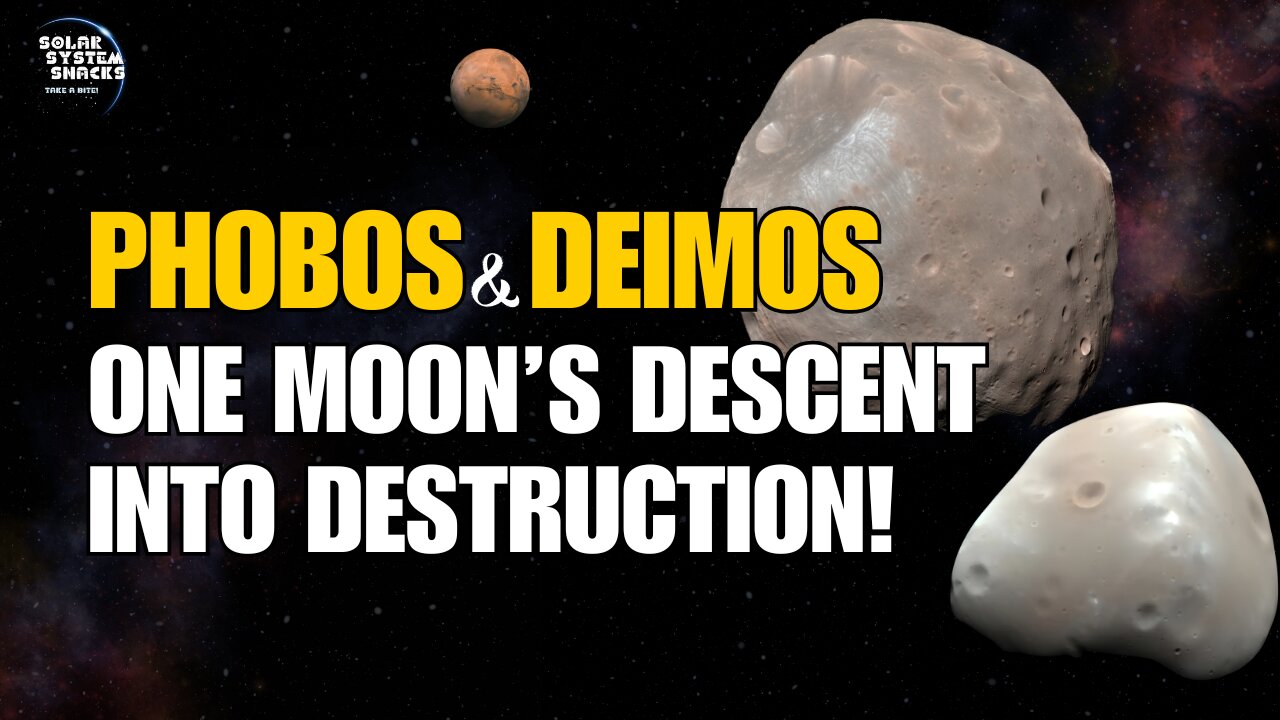Premium Only Content

Everything You Need to Know About Phobos & Deimos | Mars’ Moons
Welcome to the fascinating world of Phobos and Deimos, Mars' mysterious moons that continue to intrigue scientists and space enthusiasts alike! In this video, we’ll dive deep into the mysteries surrounding these tiny celestial bodies that orbit the Red Planet. Discovered in 1877 by American astronomer Asaph Hall, Phobos and Deimos are named after mythological companions of Ares, the Greek god of war. Despite their small size, these moons hold a treasure trove of secrets about the Martian system and the broader universe.
Join us as we explore:
Phobos: The larger moon, with a diameter of about 22 kilometers, orbits Mars closer than any other moon orbits its planet in the entire solar system. Phobos takes just under 7.7 hours to complete one orbit and is slowly spiraling toward Mars. Could Phobos crash into the Red Planet or turn into a ring system in 50 million years?
Deimos: Smaller but equally fascinating, Deimos is 12 kilometers across and orbits Mars from a more distant 20,000 kilometers. Its smooth surface and fine dust layer hint at geological mysteries waiting to be explored by future missions.
Unique Features: Both moons have irregular shapes and surfaces covered in dust and debris, creating rugged landscapes. We’ll look at Phobos' massive Stickney crater and the network of grooves on its surface, and compare that to Deimos’ smoother appearance with fewer visible craters.
Origins: Are Phobos and Deimos captured asteroids, or remnants of a larger celestial body? We’ll discuss their composition, which hints at an unusual origin story compared to other moons in the solar system.
Orbital Decay of Phobos: We’ll examine how tidal forces are slowly pulling Phobos toward Mars, and what the future holds for this doomed moon.
Key Missions: Learn how missions like Mariner 9, the Viking spacecraft, NASA’s Mars Reconnaissance Orbiter, and ESA’s Mars Express have advanced our knowledge of these moons.
Phobos and Deimos may be small, but their potential to reshape our understanding of planetary systems is huge. Whether you’re a space enthusiast or a curious learner, you’ll find this journey into the Martian moons full of captivating facts and new discoveries.
💡 Don’t forget to like, subscribe, and hit the notification bell so you don’t miss out on our latest content about space exploration and the wonders of the cosmos!
Have questions? Drop them in the comments below—we’d love to hear from you!
Stay curious, and thank you for joining us on this cosmic adventure! 🌌
#phobos #deimos #mars #MarsMoons #spaceexploration #astronomy #nasa #marsmission #asteroids #MarsExpress #marsorbiter #solarsystem #StickneyCrater #spacescience #cosmicmysteries #redplanet #futuremissions #planetaryscience #astrophysics #spacefacts #spacelovers #exploretheuniverse #TidalForces #MarsHistory #SmallMoons #spaceenthusiast #spacedocumentary
Music:
But Enough About Me, Bill Paxton by Chris Zabriskie is licensed under a Creative Commons Attribution 4.0 license. https://creativecommons.org/licenses/by/4.0/
Source: http://chriszabriskie.com/dtv/
Artist: http://chriszabriskie.com/
-
 LIVE
LIVE
LFA TV
15 hours agoLIVE & BREAKING NEWS! | WEDNESDAY 10/15/25
3,918 watching -
 LIVE
LIVE
The Mel K Show
1 hour agoMORNINGS WITH MEL K - Lawfare Operatives Panic-Nothing Can Stop What is Coming! - 10-15-25
630 watching -
 LIVE
LIVE
The Shannon Joy Show
2 hours agoCharlie Kirk Killing Exploited For Trump’s Everything War - Insurrection Against The Constitution
226 watching -
 LIVE
LIVE
Grant Stinchfield
1 hour agoJim Jordan to Jack Smith: Come Testify!
102 watching -
 LIVE
LIVE
Trumpet Daily
55 minutes agoTrumpet Daily LIVE | Oct. 15, 2025
231 watching -
 1:02:16
1:02:16
VINCE
3 hours agoChaos In Chicago; Illegal Attack Border Patrol | Episode 147 - 10/15/25
159K84 -
 1:33:53
1:33:53
Dear America
4 hours agoCharlie Will NEVER Be Forgotten… Young Republicans Are Racist?! + Dems LOVE VIOLENCE!
95.2K47 -
 59:40
59:40
MYLUNCHBREAK CHANNEL PAGE
2 hours agoWho Built the MASSIVE Cathedrals?
12.9K3 -
 1:20:00
1:20:00
The Big Mig™
3 hours agoAntifa Terrorism Follow The Money
15.8K9 -
 2:10:41
2:10:41
Badlands Media
5 hours agoBadlands Daily: October 15, 2025
52.6K9